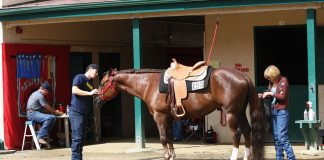 |
From a blanket wardrobe of turnout sheets, daysheets, waterproof rainsheets, midweight, heavyweight, lightweight blankets and everything in between, horse owners ponder the question of which blanket to put on today, as they attempt to dress their equines just right for the weather–not too hot, too cold and—hopefully—just right.
When choosing the perfect blanket, there are more options than ever. What should your horse be wearing this winter?
The term “denier” is used to denote the strength of outer blanket materials such as polyester or nylon. Denier is the international system for measuring and numbering filament yarns of silk and synthetic fibers. A denier is the equivalent to the weight in grams of 9,000 meters of fiber. The higher the denier, the sturdier the fabric. “Ripstop” nylon features a checkerboard or textured pattern in the weave, which helps prevent small rips from spreading and becoming large ones. “Ballistic” nylon alludes to a specific nylon originally developed for use in flak jackets. The type of yarn and weave construction helps strength and abrasion resistance (although it’s not really bulletproof!).
Polyfill is the fluffy batting inside the blanket. The fill weight”is measured in grams, and indicates blanket warmth. The higher the fill weight, the warmer the blanket. Typically, fill weights range from the light version at around 100 grams, midweights checking in around 200, and the arctic parkas weighing in at the higher end, around 360 to 400 grams. Sheets and some lightweight blankets don’t have any fill at all.
Cotton or poly/cotton linings are absorbent, while nylon linings help polish the coat. Some styles feature nylon or taffeta lining at the shoulders to help reduce rubbing. Mesh linings help enhance air flow and moisture management. Waterproof, breathable blankets have special high-tech fabric treatment that actively wicks moisture away from the horse to keep him dry and comfortable underneath the blanket, while also protecting him from the outer elements.
Water World
If you’ve ever experienced the clammy “greenhouse” effect while mucking a stall in waterproof raingear, you can appreciate the miracle of waterproof, breathable technology for your horse’s blanket. How does it work? “Waterproof/breathable technology in horse clothing means a special coating or laminate has been applied or bonded to the outer material that will not allow water droplets to pass through from the outside, but will allow singular water molecules (humidity released by the body) to pass through,” explains Liz Wilkinson, product development coordinator and U.S. horse clothing specialist with Weatherbeeta. “This means that rain and snow from the surrounding environment will not go through the material, but water vapor, which in this case is from the evaporation of perspiration, is able to escape.”
Teflon is a fabric protector that helps to prevent the fibers from becoming saturated with water, and is applied to the outside of the material—it is not what makes the fabric waterproof, Wilkinson says, clearing up a common misunderstanding. As an added bonus, the Teflon helps repel stains as well.
Water can sneak through seams, so waterproof blanket styles employ strategic seam placement to minimize exposure, and taping or reinforcing the seams to further ensure your horse stays dry.
Fit Features
Horse clothing continues to evolve and become more sophisticated, with clever solutions to ages old fit complaints. New innovations in gusset design, an inverted “V” of fabric desingned to expand to allow greater range of movement for legs and shoulders. Position of the gussets also enhances fit and helps contour to the horse’s shape, allowing the blanket to move with the horse without bunching or restricting.
The neck and shoulders have traditionally been a problem area due to rubbing, chafing and pressure points created when a horse puts his head down to graze. Look for blanket styles with elastic at the neck, contoured necklines that fit in the groove of the horse’s shoulder and neck, and darting that creates room for the shoulder. Some blanket styles feature patented closures especially designed and placed to avoid pulling horizontally across the chest. All these style innovations allow the horse to lower his head without pressure points on his shoulders.
Seams, which help enhance the tailoring of a blanket, had become unpopular in the last decade because they were prone to leaking. Seamless waterproof blankets provided improved weather protection but sacrificed fit. New waterproof seam-taping technology allows better fit and function. Contour designs provides a closer, more secure fit—no more shapeless, sack-like rugs shifting around on your horse.
Wide Body
Stock breeds such as American Quarter Horses, with their compact, broad muscles, can be a challenge to fit. Several manufacturers have designed blanket collections with these horses in mind. Some of these blankets are more boxy, as opposed to a contour cut. Stock horse friendly styles are often cut back in the neck and made wider in the chest in order to fit wide-bodied Quarter Horse types.
The New Versatility
Some horse owners like to layer blankets, but beware—some layers (such as a sheet under a blanket) can create awkward rubbing as well as a tangled mess of straps.
“Use only one blanket that is the right weight whenever possible,” Wilkinson advises. “When you layer blankets, you decrease the breathability, restrict motion and add more weight onto the horse which can lead to rubbing.”
Versatile new blanket systems designed for layering offer an alternative solution. These blanket separates are made to work together and feature interlocking fastenings for a secure fit. Styles range from two- to four-piece combos for a complete blanketing solution.
What to Wear?
Your blanketing decisions will depend on a number of variables, but the key issues are whether your horse is clipped, what type of shelter he has and his age/health. Older horses or those with compromised health will be more sensitive to cold. If you have an old-timer or hard keeper, you don’t want him burning precious calories just to stay warm. A clipped horse (or one with a thin coat) will need more blanket than one with a full coat. And a horse out in the elements will require more protection than a horse that is well sheltered from wind and precipitation.
“Don’t overblanket,” Wilkinson cautions. “Horses are outdoor animals, and they are able to cope with the cold much better than you and I. If you need three layers to keep warm, they probably only need one.” She advises using the lightest blanket that is going to get the job done, even outdoors. “When outside, horses tend to run and play, and a blanket that is too warm may cause them to overheat (yes, even when it is 20 degrees out!),” she says. See our chart for a vet’s advice on your blanketing appropriately according to the temperature.
A consistent approach to blanketing is important, according to Wilkinson. “If you only plan to blanket in the coldest, wettest weather, it is better to use a light- or medium-weight blanket. Otherwise the change from no blanket to heavyweight will be too dramatic for your horse and may actually cause him to overheat,” she advises. “If you plan to blanket all winter long, start with a light- or medium-weight blanket, and then progress to the next weight when the weather gets colder.”
For more blanket fit tips, read A Fitting Solution>>







Thanks for including this article! I had to Blanket my horse this winter and this really helped me improve my knowledge on blankets!
in your article you mention a chart to watch to help understand the type of blanket needed for the type of weather, but i could not find a chart, could you show me where it is please, thank you.
The blanketing chart is here:
http://www.horsechannel.com/horse-keeping/need-a-blanket.aspx
good info!
Great tips.